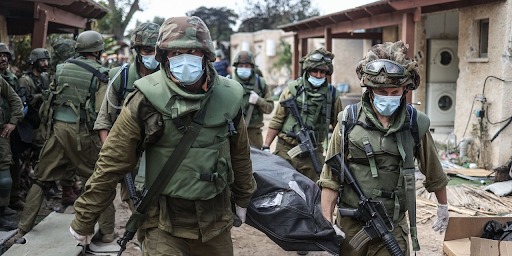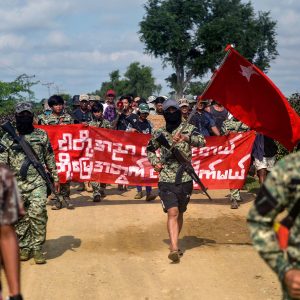“The problem of the Israeli-Palestinian conflict was always trust. This is just a case of broken trust, this is a case of broken everything.” –Professor Ron E. Hassner
Conflict Breaks Out: A Timeline
October 7th, 2023. Hamas, a terrorist group operating within the Gaza Strip, fired a cascade of around 2,200 rockets into southern Israel. As the attack commenced, air sirens went off in Jerusalem and Tel Aviv warning citizens to take cover. Quickly following the initial attack, Hamas militants stormed the streets of Gaza, building blockades and targeting not only the Jewish settlers in the area but also other innocent civilians.
Under the heavy cover of rockets, Hamas militants pushed on, bulldozing through the Israeli-Gaza border and entering Israel utilizing a variety of vehicles including those equipped for land, air, and sea. The fighters targeted the Tribe of Nova Music Festival, blocking off all festival exits, killing over 360 attendees, and taking hostages. They expanded their reach, entering villages and towns throughout parts of Israel, killing, mutilating, and raping dozens of men, women, and children while taking additional hostages, eventually totaling 200–250.
Shortly after the violence began, Mohammed Deif, Commander in Chief for Al-Qassam, the military wing of Hamas, released a video statement taking credit for the attacks. Meanwhile, Sahel al-Arouri, deputy chief of Hamas within the West Bank, made a call to arms to all Palestinians within the West Bank to stand and band together against Israel.
Al-Sousi Mosque after Israeli airstrikes
Image Source: CNN
That same day, Benjamin Netanyahu, the current Prime Minister of Israel, swiftly made his first statement to the Israeli public regarding the actions of Hamas, asserting that “Israel is at war.” Israel’s military spokesperson also addressed the public shortly after Prime Minister Netanyahu, alerting the people that the Israeli Air Force was immediately deploying fighter jets to carry out airstrikes in Gaza.
By the conclusion of the first day of fighting, between 150-250 captives had been taken, many of whom were either dead or wounded, and all watching around the world were in shock.
Within the U.S., President Biden and Antony Blinken, U.S. Secretary of State, addressed the public condemning the actions of Hamas and fully backing Israel. Soon afterward, President Biden spoke with Prime Minister Netanyahu, making certain to reaffirm the U.S.’s support of Israel as the fighting persisted. Material support from the United States, in the form of defense materials and equipment, first arrived in Israel on October 11th, just four days after the initial attack. Later, on November 2nd, the U.S. House passed a bill dedicating $14.5 billion in military aid for Israel.
In the time since the initial attack began, Israel has launched responsive airstrikes at Gaza while warning civilians to move out of the area beforehand. Some of these targeted and flattened the Al-Sousi Mosque, along with many other areas of Gaza. The Israeli Defense Force began an official ground invasion of Gaza toward the end of October in an attempt to fight Hamas from the inside. That said, the validity of information regarding the specific actions of Israeli defenses, much like information generally surrounding this conflict, has been difficult to determine.
To illustrate, on October 17th, days after the initial assault, al-Ahli, a hospital in Gaza City, was targeted by a rocket strike that caused an explosion, killing at least a hundred people. Confusion erupted over who was responsible for the attack. Initially, some placed blame on Israel’s military, but later video evidence undermined this contention, suggesting that an Israeli bomb was unlikely.
Map of the Gaza Strip.
Image Source: New York Times
Around the world, many protests have broken out in support of both parties to the conflict, some peaceful, and some becoming highly violent. Even on BPR‘s own Berkeley campus, protests, and walkouts are taking place multiple times a week in support of either Palestine or Israel. The spread of content created by Hamas via the internet and social media has been rapid and devastating to consume, likely provoking at least some of these protests.
As a consequence of the conflict, around 1.5 million people living in Gaza have been displaced, rushing toward the Egypt-Gaza border to seek refuge from the fighting as Israel urged all citizens living within the conflict zone to flee their homes for safety reasons. On October 15th, after much hesitation, Egypt agreed to open its borders to accepting international citizens who had been trapped in Gaza, causing chaos amongst people at the border.
One thing remains constant: many, if not all, including the United Nations and other NGOs, are calling for some sort of ceasefire at this point in the conflict given the high rate of casualties and increasing violence. As of November 13th, Hamas claims that the death toll in Gaza has surpassed 33,000, and the Ministry of Health within Gaza has made the claim that 7,000 people are missing. However, the Israeli government along with the U.S. government have both claimed that Gaza is inflating these numbers, and some researchers have suggested that Hamas is downplaying the number of militant deaths as opposed to civilian casualties.
Analysis of the Situation: Interview with Professor Ron E. Hassner
Professor Ron E. Hassner, holder of a chancellor’s chair in the Political Science department at UC Berkeley, and faculty director of the Helen Diller Institute for Jewish Law and Israel Studies, sat down with me several times to discuss the conflict in detail and provide his perspective and analysis.
To begin, Professor Hassner and I discussed his general views on the conflict as of October 11th. Hassner’s general sentiment regarding the conflict was and remains appalled. Hassner described the actions carried out by Hamas as “a combination of homicidal mania and sexual perversion,” referring to the murder of young children, rape of young women, and massacre of people in general.
Closer to home, Professor Hassner was also saddened by the rising tensions, violence, and claims being made by and between students here on the Berkeley campus. While understanding the anger and emotional state of many students, Professor Hassner hopes that students can move toward a more cognizant stance, or at least a less violent path of political involvement, a sentiment he alluded to during the interview as well as in his courses.
When asked how this specific outbreak of violence is different from previous issues between the two groups, Professor Hassner highlighted three main distinctions. This flare-up was not preceded by any increase in tensions as previous disputes have in the past. Many kidnappings occurred not just of soldiers but women, children, and the elderly, some of whom are Israeli and some not. Finally, this outbreak has been wildly more violent than previous occurrences of conflict involving Hamas.
In this instance, Hamas has committed atrocities that no other terror organization has committed before within the Arab-Israeli conflict. Other terror organizations such as ISIS have shown this level of barbarity; however, Hassner makes it clear that historically, Hamas has never done so until this point. An example of this level of violence is the incident that is being largely referred to as the musical festival incident. Professor Hassner recounts the event:
“We know that one of the targets of the attack was a large musical festival in which thousands of Israelis and non-Israelis were sort of having a peace celebration, dancing in the desert, and then Hamas gunmen showed up and started just machine gunning people. We now learn that after people started running and the dead fell with the wounded between them, these terrorists went and executed everyone that was lying on the ground, then used a bulldozer to pile the bodies into a giant pile to set them on fire. That served no purpose whatsoever, it makes no sense. It’s just carnage.”
Further analyzing the issue, Professor Hassner claimed that these actions make no reasonable sense for a few reasons: they get in the way of hostage exchanges and leverage, and they make Israel not want to negotiate with Hamas. It seems to be a very easy line drawn in the sand between sticking with and supporting whoever you want to support and possessing basic humanity for others.
This attack was very surprising to the Israelis because the “audaciously executed surprise attack” came out of nowhere during a period of relatively stable conditions for the region. It’s clear that Israel was relatively surprised by the launch of an attack. As to the question of whether Israel’s intelligence system, which holds the reputation of being held at a high standard, failed Israeli citizens, Professor Hassner made an important clarification regarding intelligence in general:
“Intelligence is tough, and you get a million and one warnings a day, most of which are false, most of which you should ignore, some of which are intentionally false, enemies trying to make you jumpy and get you to prepare for an attack that’s not happening. Maybe even provoke an attack because you think the other side is attacking, so I’m sure that there was a lot of intelligence, the question is how negligent were the Israelis?”
Relating to the specifics of topics like providing aid to those in the Gaza Strip, and whether Israel’s decision to cut off all water, power, and similar resources to the region is an ethical one, Professor Hassner makes the complexity of the situation clear once more. Resources and humanitarian aid pose a real challenge since there is always a possibility that the aid could be intercepted, withheld from the Palestinian people, and instead used to supply and ultimately help members of Hamas.
Another possibility is the aid being used as leverage to get members of Hamas to release the 250 hostages. All Israel can really do is restrict the availability of resources to the region which, as many have pointed out, brings up ethical issues since it not only hurts members of Hamas but civilians as well. To this point, Hassner is explicitly clear:
“We are not in the realm of ethics here, we are in the realm of war. Nobody expects Ukraine to supply water and electricity to Russians. Hamas has played this very smartly, they are holding well over one million Palestinians hostage within the Gaza Strip. It is very hard for Israel to harm Hamas without harming the civilians Hamas is hiding behind. The best Israel can do is to say to the Palestinian people, ‘Get the hell out of the conflict zone.’”
Historically, the conflict seems to be largely charged by religion and religious beliefs. When I asked Professor Hassner whether he thought the conflict remained centered around religion, he replied that it was, in fact, quite the opposite. Hamas has instead strayed away from being a political movement on behalf of Palestinian liberation with the intention of freeing the Palestinian people and their former territories, a claim Hassner does not believe makes sense in the first place because Hamas was already in control of said land and people:
“Some people cling to this idea that Hamas was a liberation movement. Nothing that happened in the last four days supports that, they didn’t do any liberating. For example, the places where they fought [referring to Israel’s territory] are not historically disputed parts of Israel-Palestine, these territories were Israel’s proper.”
The message Hamas is trying to send is at best muddied and unclear, as are their intentions or what they hope to accomplish with these actions.
“If your very angry, blow something up, drop a bomb, shoot some people, but raping 18-year-old girls and then parading them through the streets of Gaza while they are bleeding from their crotches, what is that? I don’t understand what that is. What message are you trying to send? If you are trying to send me a message, I don’t understand the message, it’s like you’re talking gibberish, you seem to be crazy. What do you want me to do about the fact that you are crazy? I don’t know what to do now.”
Instead, Professor Hassner draws on ideas proposed within Mark Juergensmeyer’s book Terror in the Mind of God. Juergensmeyer’s main argument is that religious terrorism is different from traditional terrorism in that with religious terrorism; it is a performance for God, to show God that we are ready for the next stage, we are ready for “judgment day,” so to speak. This performance or showcase requires sacrifices both small and large which result, at times, in mass atrocities.
A second proposal Hassner gives is relating to the principal-agent issue proposed by Princeton University Professor Jacob Shapiro:
“Principal-agent problems are uniquely bad in terrorist organizations because they have to communicate with leadership, and because leadership is often not in touch with the people that are actually executing their commands. Hamas leadership are nowhere near the Gaza Strip or Israel, they are in different countries. And so, it could be that the Hamas leadership had a very concrete rational goal, but they weren’t able to convey that goal in great detail to the terrorists on the ground because it all has to be covert.”
A final, major distinction that is crucial to make is the fact that Hamas and the Palestinian people are not two terms that should or can be used interchangeably. It is important to understand that not all Palestinians agree with the actions of Hamas, the same way that not all Israelis agree with the actions taken by Israel. It is impossible to divide this conflict into two distinctly separate holistic groups because the situation is just not that simple. Professor Hassner agrees:
“It’s hard to make that distinction when Palestinian students on our campus celebrate Hama’s actions, valorize it, praise it. This would be a great time to explain to everybody that Israeli protesters are not Israel, and Hamas is not Palestinians. […] This is the time to say my allegiances are here, I don’t support those guys over there, but what my side did was inexcusable and horrific and I wish I’d never seen those images.”
The final questions I was able to ask Professor Hassner had to do with the use of terms such as “genocide” and “ethnic cleansing,” which have been repeatedly leveled against Israel’s actions in Gaza, and whether these are fit terms to apply to the scenario. His responses were as follows:
“No, I think they are using just the strongest, most explosive words they can so they can get a lot of people’s attention. I’ve heard that people say things like policing within the U.S. is genocide. The problem is that using really strong words to describe other things is that when genocide happens, you’ve devalued the word.”
“The Israeli-Palestinian conflict is now entering its second century. If either side had intended for genocide, they would have done it by now. The harm has been significant but has extended to 1% of the population so, I can imagine it’s awful and many have died, but it is neither in intention or scale what you would consider a genocide.”
“Did Hamas intend genocide on Saturday and Sunday? 1,500 almost 2,000 dead is awful, but it’s not genocide, it’s terrorism, and the ground war for the purposes of counter-terrorism is also not genocide.”
As to the future of the conflict, Professor Hassner expressed concern over the involvement of Iran and Hezbollah’s involvement in the issue, saying that “[i]f Hezbollah should join in the fight, then this will be a proper war, not just counter-terrorism, but war, and the fatalities will be 10, 100 times this current rate.” Many questions are left in the minds of people everywhere, yet the situation is so unprecedented that we are seeing history unfold directly in front of our very own eyes which is why the future is so difficult to predict. It seems that the world has entered a new era of terrorism, much like we did when the events of 9/11 unfolded within the U.S.
For his part, though, Professor Hassner provides a clearer point of view:
“It means that the history of Hamas has come to an end. No government anywhere in the world would allow an organization like this to live on its border. Hamas is hoping that Israel will be deterred by the hostages, but most Israelis understand that the hostages are a lost cause. Hamas hopes that Israel will be deterred by the international community which would usually restrain Israel because so many citizens are likely to be harmed, but the international community is backing Israel completely.”
Featured Image Source: The Wall Street Journal











Comments are closed.